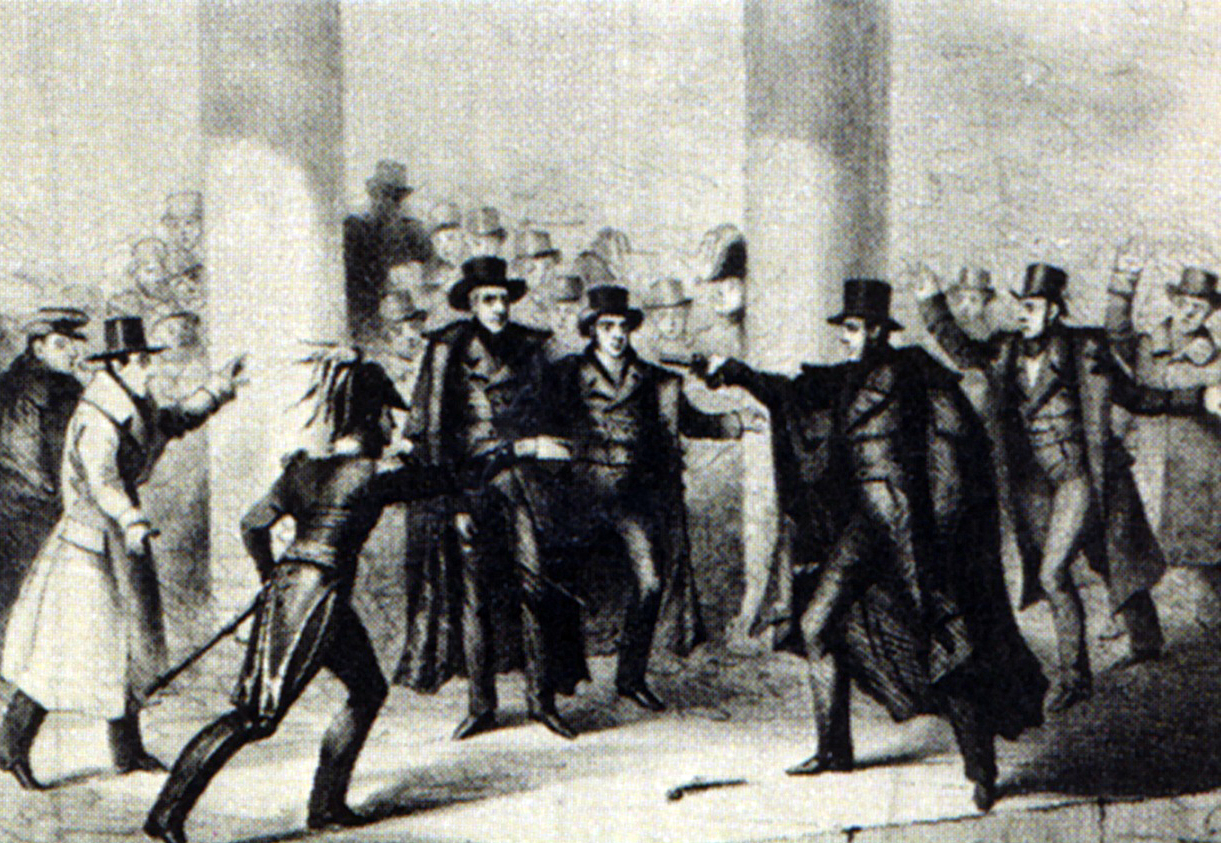Where Bullets Land

Chapter I: Mad Man Behind the Colonnade 
The seed that killed the Democratic Party was planted by the pistol of a mad man, Richard Lawrence. Born in England in 1801, he and his family immigrated to the state of Virginia during the War of Impressment, where it is said that he had a completely normal childhood. [1] But on the morning of January 30th, 1835 he would cement his own legacy as a deranged assassin, and set the Democratic Party on a track of infamy and self-destruction. President Andrew Jackson was attending the funeral of congressman Warren R. Davis at the Capitol building in Washington D.C. As he left the funeral, Lawrence emerged from behind a pillar, pulled out his pistol and fired a point-blank shot into the back of the President. [2] The President collapsed forward to the ground as a nearby Navy Lieutenant, Thomas Gedney, charged at Lawrence, who pulled out a second pistol and fired it at Gedney, killing the Navy Lieutenant. Before the assassin could escape, Congressman Davy Crockett tackled him to the ground and kept him subdued until a policeman was able to arrive and arrest him. President Jackson was quickly taken from the scene to a nearby hospital, but by then it was too late. His lung had been punctured, and died within hours.
The subsequent trial was the biggest in the nation’s history up to that point. Jackson’s supporters initially suspected a political motivation for the attack, many pointing to Mississippi Senator George Poindexter, whom it was revealed during the trial had hired Lawrence to paint his home in D.C. As the trial continued the true extent of Lawrence’s mental feebleness was revealed, believing he was King Richard III, and that President Jackson was preventing him from collecting money owed to him by the American Colonies. Despite Lawrence’s evident insanity, the prosecutor, Francis Scott Key, sought the harshest punishment possible… death. Had the attempt on the President’s life failed, he may have gotten off with a plea of insanity. But because his bullets found their marks inside the torsos of a President and a Navy Lieutenant, he was found guilty on one count of first degree murder, and one count of second degree murder. He was sentenced to death by hanging in June of 1835.
Political drama was occurring before the Trial even began. With Andrew Jackson being the first President to not serve out the full term he was elected to, the issue of succession had not yet been determined. The Succession Act of 1792 had made arrangements if both the Presidency and Vice Presidency were vacant, but not if just the Presidency was open. Article II, Section 1, Clause 6 of the U.S. constitution said that the powers and duties of the President would devolve to the Vice President, but it was not clear if the office itself was inherited. Vice President Van Buren took initiative and sent a message to Jackson’s cabinet about his plans to assume the presidency, and located the recently appointed Associate Justice James Wayne, who administered the oath of office. This move initially sparked outrage in the Senate, which was controlled by the anti-Jacksonians, who argued that Van Buren could only be considered Acting-President. They butted heads with the House of Representatives, which was controlled by the Democrats at the time, who recognized Van Buren’s ascendency. Although numerous controversies erupted around this issue, by the time the trial of Richard Lawrence had started, the 24th congress had replaced the 23rd, at which time both houses were controlled by the Democrats, who gladly recognized Van Buren’s Presidency, but this was just the beginnings of Van Buren’s troubles in office.
From, The Rise and Fall of the Democratic Party, by Jonathan Alberts (1990, William & Marry Press) [3]
[1] ITTL, the war of 1812 is sometimes referred to as the “War of Impressment” by American scholars.
[2] This is the PoD. IOTL both pistols misfired.
[3] One of many fictional texts that will serve as the narrative format of TTL
---------------------------------------------------------------------------------------------------------------------
I’ve done timelines in the past with this PoD before, and a chunk of this timeline will be reusing elements from those, but I’m treating this timeline as being a completely separate one because there are going to be significant changes in how things progress. For the U.S., the changes from my older timeline “A Long and Flowing Whig,” will become more prevalent after the American Civil War. Before then, though, there will be quite a few changes that, although not changing the trajectory of the timeline until after the civil war, will have big ramifications for certain Characters (A very different fate for Abraham Lincoln).
There will be a rather large change ITTL from ALFW in another theater, Europe. Either in the Next chapter, or a few down the line, I will be giving the second PoD for this timeline that will set Europe down a different path from both OTL and ALFW. Because these changes, at least in my eyes, are so significant, I’ve decided to dedicate this Timeline as something completely new, rather than the umpteenth attempted rewrite of an older one.
